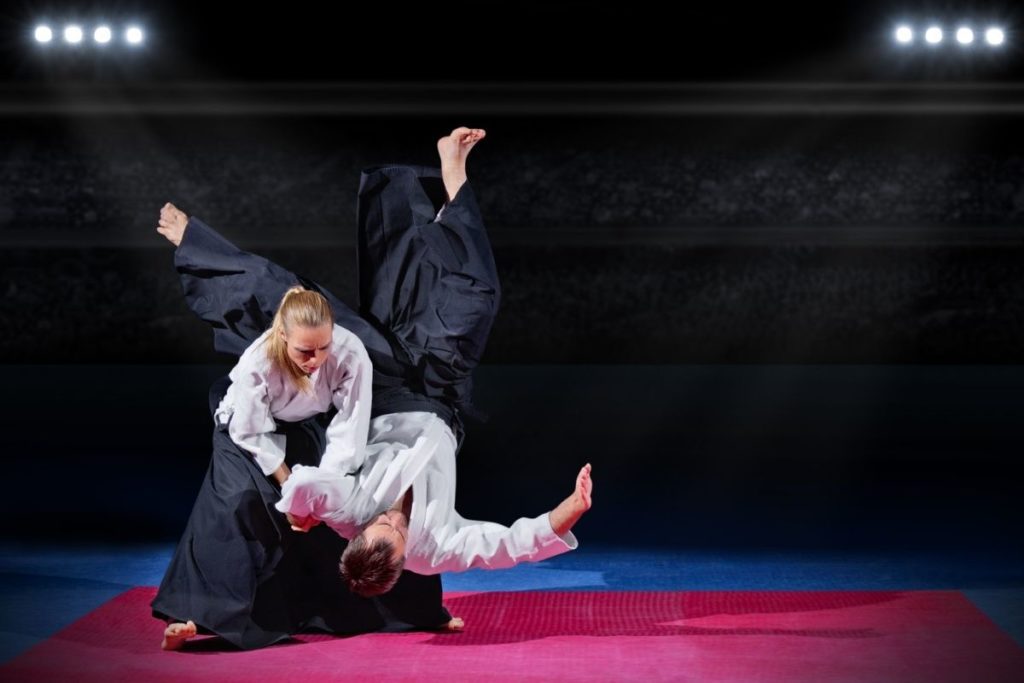Aikido is one of the most practiced martial arts in the world. You might be surprised to learn that it has over one million practitioners worldwide. It also boasts among its practitioners movie stars like Steven Seagal; in many of his movies, you see Steven Seagal using real Aikido techniques to dispatch his foes with panache.
Despite this, Aikido has garnered a reputation in the Brazilian Jiu Jitsu and martial arts community for being ineffective. This article will delve into the history of Aikido, and compare it to Brazilian Jiu Jitsu to give you a more comprehensive understanding of this martial art!
What is Aikido?
The word “Aikido” (pronounced: I-key-DO) is composed of three words that roughly translate to:
Ay – Harmony
Ki – Energy
Do – Path
Aikido practitioners often describe the term as meaning the “Way of Unifying.” Aikido is an art which uses a combination of joint locks, throws, pins, and strikes to subdue an opponent, often without injuring them. Aikido also teaches how to use and defend against three weapons:the bow staff, knife, and sword.
Although Aikido can be described as a martial art, it is better described as a series of techniques coupled with a philosophy of self discipline and non-violence. Aikido preaches that a warrior should be able to “defeat oneself” before defeating others. Aikido practitioners are taught to develop high moral character and self development.
Aikido practitioners are referred to as “Aikidoka” similar to “Judoka”. Although there are many branches of Aikido, the original school is called the “Aikikai” and is headquartered in Japan. The leader of the Aikikai branch is called the “Doshu.” All of the Doshu have been in the family of the founder of Aikido, Morihei Ueshiba.

History of Aikido
Recently Aikido has come under fire in the martial arts world for not being effective. You might be surprised to learn that Morihei Ueshiba had something very different in mind when he founded Aikido in the early 20th century. Also, it should be noted that the martial art was not originally called Aikido, and was instead originally called “Aki-Budo.”

Morihei Ueshiba was heavily influenced the Shinto religion. Shinto is a religion that teaches non-violence, and Morihei incorporated this and many other Shinto beliefs into his marital art. Ueshiba’s philosophy of non-violence was also heavily influenced by World War II and the bombings of Hiroshima and Nagasaki.
Ueshiba today is a figure very similar to Jigoro Kano, the founder of Judo (Kano would go on to teach Mitsuyo Maeda who would go on to teach the legendary Gracie family). People who dislike Aikido might not be aware that Kano and Ueshiba actually met each other in Japan and were said to have enormous respect for one another.
Today many Aikido schools refer to Morihei Ueshiba as “O-sensei.”
Aikido Today
Aikido spread all around the world and is now taught in over 140 countries. Like many martial arts it has split into variations and different schools. Some of the reasons for this were disagreements with the central philosophy of non-violence. Many Aikido gyms do not participate in competitions as Morihei Ueshiba felt competition went against the spirit of the art.
Morieh Ueshiba reportedly said “There are no competitions in the art of peace.” Nonetheless the Shodokan version of Aikido does hold competitions, as do other minor branches of Aikido. But most Aikido schools do not compete.
Aikido vs Brazilian Jiu Jitsu – Similarities and Differences
Brazilian Jiu Jitsu and Aikido have very different ways they rank their practitioners. It should also be noted that it takes much longer to rank up in Brazilian Jiu Jitsu instead of Aikido. Having a black belt in BJJ carries a large amount of esteem in the martial arts community.
BJJ uses a 5* belt ranking system, similar to many traditional martial arts. The ranks in BJJ are:
- White Belt
- Blue Belt
- Purple Belt
- Brown Belt
- Black Belt
*There are also two coral belt ranks, and a red belt rank awarded instead of a 10th degree black belt. However these belts are not normally included when describing the ranking system.
On average it takes more than 10 years to become a black belt in Brazilian Jiu Jitsu. Being a black belt in BJJ means someone has a huge knowledge of grappling martial arts. Because BJJ has live sparring (known as rolling) in every class, it is incredibly difficult to lie about being a black belt in BJJ. If someone doesn’t have black belt level skill in BJJ, it’s very obvious.
Aikido Ranking System
While BJJ has five belt ranks, Aikido has just two. There are white belts and there are black belts. However, the “degrees” (or dans) of black belts in Aikido are considered very difficult to achieve with the seventh Dan being the highest. Before someone gets their black belt, they receive “Kyu,” which are levels for white belts.
Students start at the 6th Kyu, and work their way up the rank by progressing down in Kyu. For example, the first promotion a student will receive is from 6th Kyu to 5th Kyu. A black belt is awarded after the 1st Kyu.
It should be noted that some of the branches of Aikido have added color belts, sometimes using color belts to represent each different Kyu.

Tests
Neither Aikido or BJJ require tests to be promoted, however it depends on the gym you are training at. There are some BJJ schools that have testing and there are some Aikido schools that have testing. Generally BJJ schools tend to not have testing and your rank is determined by how you roll with higher and lower belts.
Rule Sets
The rule sets in BJJ competitions award points to competitors based on dominant positions, and a practitioner can win the match by securing a submission. The rules in Aikido competitions closely resemble Judo competitions, however Aikido practitioners are not allowed to grab their opponent’s gi.
Another difference from Judo is that instead of securing a win by a throw, Aikidoka score points based on how far they can take their opponent to the ground. For example if someone breaks their opponent’s balance they get one point, while if they complete the takedown they get four points.
One of the more interesting things about Aikido competitions is they have a variation which uses a styrofoam knife. One competitor will try to stab their opponent and score points if they do. The other competitor has no knife and their goal is to try to take down their opponent while simultaneously protecting themselves from the knife.
Sparring
In BJJ sparring is called “rolling,” and generally BJJ practitioners roll every class. There are no strikes involved, with practitioners trying to secure positional dominance and submissions. A submission can be a choke or joint lock.
Because of the beliefs of Aikido founder Morihei Ueshiba, most Aikido schools do not include any kind of sparring. The branches of Aikido which have competition include Shodokan Aikido and Tomiki Aikido. Both of these host tournaments where practitioners compete for points. However, for all intents and purposes Aikido is not considered a “combat sport.”
Weapons Training
One of the biggest differences between BJJ and Aikido is the use of weapons. Aikido primarily focuses on three: the short staff, the knife, and the sword. Aikido was created during a tumultuous time in Japan and this is why Aikido practitioners focus so much of their techniques around wrist locks; Ueshiba wanted his practitioners to be able to disarm opponents.
This emphasis on disarming is why in Aikido competitions, only one opponent has a knife and the other does not. Some Aikido schools also teach how to disarm people with firearms. Aikido’s focus on wrist attacks is transferable to BJJ in the form of wrist locks.

Uniform
Aikido and BJJ both wear the Gi. However Aikido, unlike BJJ, does not have a no-gi variant. Also during Aikido sparring it is illegal to grab your opponent’s gi. This is unusual for BJJ players because the Gi can be employed for collar chokes and control mechanisms.
The uniform for Aikido is called the “Aiki-dogi.” The pants and skirt that is worn over the Aki-dogi is called the “hakama.” These pants were traditionally worn by samurais in Japan. The rules as to when and what ranks you are eligible to wear the hakama differs from school to school.
Aikido and BJJ in film
The large sweeping spinning “throws” in Aikido fit the big screen much better than BJJ. “Throws” is in quotation marks because the spinning that occurs in the air isn’t actually a result of the wrist being turned. Instead it’s what Aikido practitioners do to unturn their wrist from the lock. For the big screen many aspects of martial arts are exaggerated, and Aikido is no exception.
Unlike Aikido, BJJ is generally a fairly plain looking martial art. Many of the moves and chokes rely on small, hard to see movements, but have a reputation for being widely effective. Flashy moves in BJJ, like the flying armbar, are considered less effective and dangerous because of uncontrolled falling bodyweight. Many BJJ competitors don’t use them.
Old school martial arts movies relied on highly skilled action heroes like Steven Seagal, who is a seventh degree dan blackbelt in Aikido. Seagal (who is 69 years old) has recently come under fire for gaining a lot of weight and not starring in any recent films.
Steven Seagal has not only starred in action flicks. He has also been a consultant on movies like James Bond. Sean Connery apparently trained with Seagal to get in shape, and learn martial arts for the movie Never Say Never Again. After the movie came out Connery revealed that Steven Seagal actually broke his wrist during the training for the movie.

If you watch more modern action movies like John Wick, you will notice techniques from both Aikido and Jiu Jitsu.
FAQ’s
How do you pronounce Aikido?
Aikido is pronounced “I-key-DO.” Which (roughly) translates to “The way of unifining.”
How long does it take to get a black belt in Aikido?
On average it takes 5 years to get a black belt in Aikido. However with consistent training you can get it in less time.
Does Aikido Have Competitions?
The majority of Aikidio schools do not compete or spar, however, some of the smaller branches of Aikido do. These competitions are scored on points, and some include attackers armed with foam knives.
What’s the Difference Between Aikido and BJJ?
Brazilian Jiu Jitsu is a submission grappling martial art. While Aikido does have some aspects of submission grappling, it includes strikes, and weapons. It is also coupled with a philosophy of non-violence.
What belt rank does Steven Seagal hold?
Steven Seagal is a 7th Dan Aikido black belt.
Conclusion
“If you know the way broadly you will see it in everything.”
– Miyamoto Musashi, author of the Book of the Five Rings.
Although the critique of Aikido not being effective is a fair criticism, it is not one that reflects a deeper understanding of the martial art. Aikido is also a philosophy that was founded around non-violence and self-discipline. If you are trying to learn self-discipline and a great deal about Japanese culture, Aikido can be a great tool to enrich yourself.
If you are a BJJ practitioner, Aikido can supplement your game by teaching you more wrist locks, although you’re better off learning the basics before diving deep into that rabbit hole. Aikido is not effective the way BJJ is, however to be a complete and well-rounded martial artist, it’s important to understand you can learn something from everybody.

Jack is a D who holds a bachelors degree in English Literature. He enjoys traveling, reading, and the Bow and Arrow choke. One day he hopes to teach English overseas and become a published author.
